|
Happy Thanksgiving!
Leading the Tribes: My next best-selling book is in the pipline. Discover why transactional managers will soon become extinct...
Let’s face it! The days of the old hierarchical organizational chart are finished. It is like old underwear that has indeed served its purpose yet seen better days. Though comfortable and familiar, it is time to let it go. It is time to move on. It is time for something fresh, new, and better capable of supporting (pun intended) your current human assets. We have relied on the old thing far too long and frankly, we have
become blinded to the potential of something else being better as a way of organizing our people. It’s true that old Uncle Hierarchy makes it easy to see who reports to whom with whatever title they hold. However, it creates problems that just do not fit the modern narrative. For example, Uncle H does not promote instant communication that technology now makes possible. Today, an engineer in the field can make the CEO aware of an opportunity or problem with one quick text. I know I know, the paradigm states that people at thetop
of the structure must be insulated from the masses by layer upon layer of people to filter decisions and information from those closest to the action. Well I say malarkey! It sounds like a good idea on paper. In reality, it actually makes CEOs and other apex leaders incapable of making sound decisions quickly when opportunities arise. Time can be cruel to opportunities. Problems can fester because people in the middle either filter information or decide not to take
action. There are also implications created by layering that actually obstruct communication. Layering causes the proliferation of organizational silos that prohibit lateral communication. Information must flow to the top of the silo to a decision maker who then communicates to someone atop the other silo and then down to the individual in the next silo who will actually act upon the decision, problem, or opportunity. Gah! How well does
thisworkin real life? And, does the information ever get back to the originator in the previous silo? Departmental conflict is also more likely in traditionally layered organizations. It is common for production departments to be at odds with quality, maintenance, or sales departments because the corporate values become diluted as they filter down from top to bottom. Executives are completely insulated and therefore blind to inconsistency at the point execution. Unclear goals and even goal conflict arise from competingpriorities. Decisions
that look good on paper can be disastrous in execution. For example, a CEO wants to increase organizational productivity. He asks his VP if this is possible. The VP says yes and communicates the directive to increase production to a plant manager. As a result of the request, a production manager is told to increase production by a certain number of units per day. In order to do this, she must speed up the manufacturing process. In doing so, the number of defective
productsincreases. An employee injury occurs because he wanted to rush his work to meet the new goal. A machine goes down because a scheduled maintenance activity is delayed. The law of unintended consequences occurs. No one in the chain wants to say no and the CEO never gets the true impact of his decision for the organization. And finally, how well do the consequences of the CEO’s decision ever really get back to him? Over time, the new production rate
becomes the expectation because it has been accomplished in the past. Sound familiar? At this point, most readers are thinking, “He’s talking about us!” Be assured that this is more common than not because organizations are simply not organized to communicate effectively. Following are five organizational chart hacks that will make you rethink how you organize.
- Think atoms rather than layers. There are big atoms and little atoms but they all have a similar structure. The nucleus is the leader of that atom. This nucleus is the servant leader that holds the atom together. Each atom represents a department or function in your organization. Each atom has electrons who are team members with different valences.
- Think fluid not gravity. In the reality of gravity, information flows downward more easily than upward. In fluid, each atom represents a function or department that can float above, below, and even beside another. Think three dimensions rather than two in a traditional org chart.
- Think mothership. Senior management is a big atom in the fluid. It is the keeper of the resources needed by the smaller atoms in the fluid. Each electron of the mothership atom is a vice president that reports to the CEO in the center of the atom.
Continue Reading...
_________________________________________
In case you missed...

Making the Migration to Tribes
I don’t want to go! Please don’t make me go! Leaving the world of transactional management is a noble idea. However, many executives cannot seem to take the first step. They expect natural, organic change that occurs slowly over time. Blah, blah, blah! Contemporary thinking requires a deliberate strategy to build tribes that make your workplace “sticky” for talent. I recently worked with a
manufacturing organization where 19% of the employees don’t show up for work daily. Can you say ouch! Imagine the costs they are experiencing. What are the costs in quality, safety, and employee morale? They have been slowly conditioned to hire more people to cover the absenteeism. People are strained and over-worked. This is their new normal. Does this sound familiar? There is a solution to this reality that is faced by so many organizations. Aggressive leaders can accelerate the formation and transition to a culture based on tribal leadership. Supervisors are the key to the resolving this challenge. Smart leaders are engaging and reinforcing our natural tendencies to be drawn into tribes. Tribes are sticky. Everyone has a role. There is a common purpose. Great team members actually show
upand make a difference. People are motivated and there is a sense of abandonment when coworkers are absent. We don’t want to let our tribe down. Tribes create a sense of “us” versus “me” and the results are powerful. Continue Reading...

Love Particles
Tina Turner may have asked the right question when she implored “What’s love got to do with it?” in her 1984 pop hit. Some of you may need to google the song – shaking my head with the big-eyed emoji. The question she poses gets very interesting when we apply it to business. What does love have to do with business? Can we or should we love each other at work? Be honest with yourself because this question is a
litmus test for where you stand on the scale between transactional management and tribal leader. Do you really attempt to love the people you supervise or work with? Transactional managers exist for the transaction of work for pay. Tribal leaders, on the other hand, seek to enhance a sense of belonging that is rooted in love for the individual and the organization. Recently, while I was teaching a class on the virtues of positive safety, a seasoned manager suddenly made a loud sigh and slammed his fist on the table. It disturbed everyone in the room and of course he had our attention. When I asked if he was ok, he made a profound statement. He declared, “He has been conditioned over his entire career to emphasize the negative or the exception in business”. He further stated,
“Hehadjust made the realization that he has had business backwards all along”. Kaboom! He was just hit with the love particle. I made a commitment to myself several years ago that I would live my life like a proton. My mission in life is to spread my positive charge to everyone I meet, with every encounter, and with every opportunity to speak or teach others. Of course we know there are many electrons (negative charge) and even some neutrons with no charge at all. Being positive is a choice. We choose our particle.
Continue Reading...
______________________________
Leading the Tribes Training - Book my 1-day class at your location for managers and supervisors.
Leading the Tribes Keynote Speech - Book my 1-hour speech for your event.
Call (903) 295-7400 Today!
____________________

Need a Keynote Speaker?
"John Grubbs' keynote message is powerful! John is able to clearly convey his knowledge and foresight on the generational changes that affect ALL of us. I had many A-ha moments with his vivid examples. We continue to talk about what his message taught us to this day. You will have to reach for a tissue to wipe tears of emotion and laughter. John's message is memorable and inspirational!"
Maria Gallegos
Texas Chemical Council
Call John Grubbs (903) 295-7400


|











